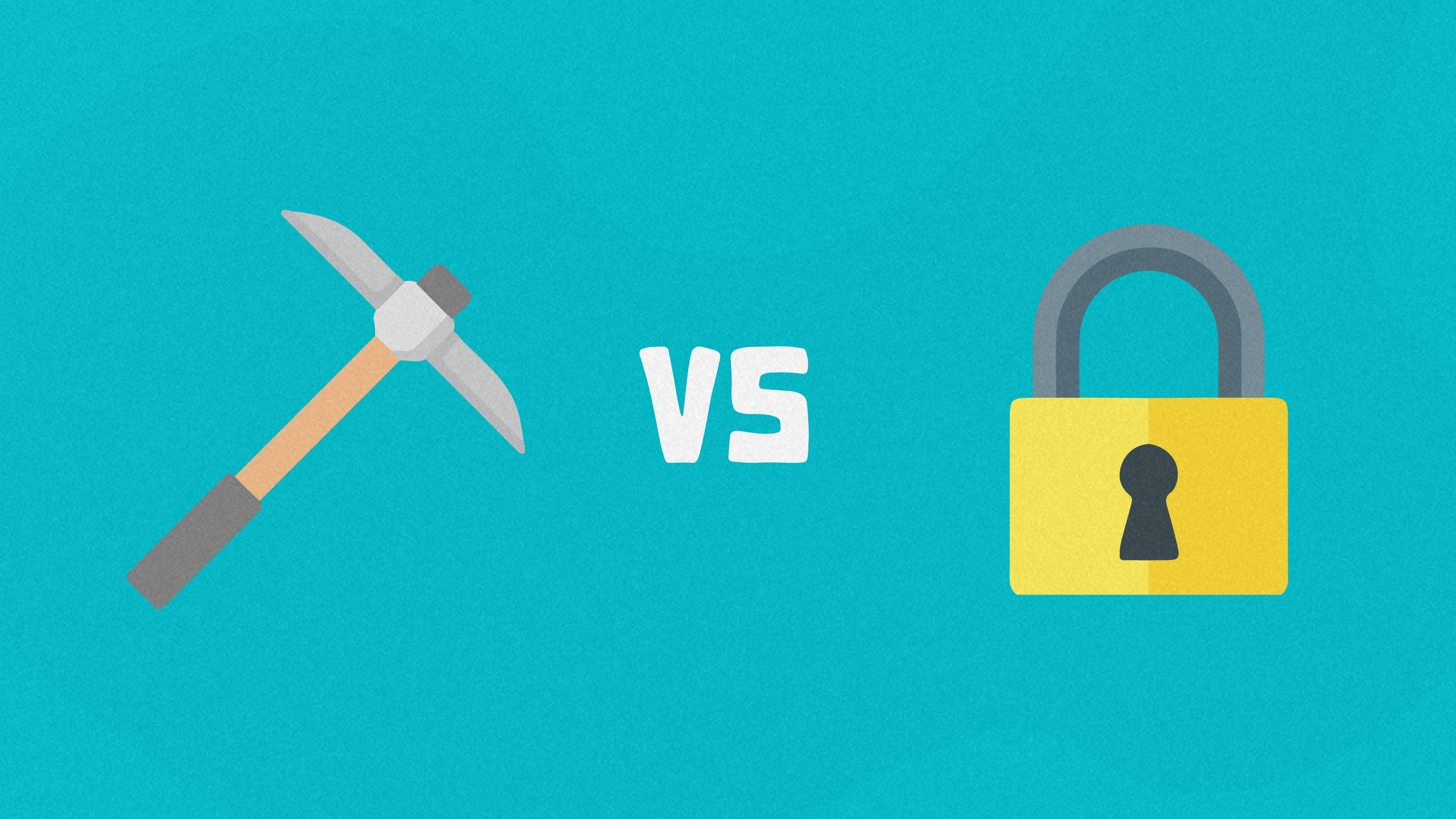Proof of Work and Proof of Stake are two essential parts of blockchain technology. They are consensus mechanisms that control the coordination and maintenance of blockchain technology. This is because blockchain is a distributed ledger of transactions, a recorded data exchange of value.

Therefore, participants must agree on a standardized mechanism for how blockchain nodes operate. Also, they must agree on a proper way to keep this ledger of transactions in order via a consensus algorithm.
Blockchain consensus algorithms preserve the transparency and reliability of the transaction while preventing deliberate cheating in a decentralized manner. It also aids blockchain networks in agreeing on an authentic and valid transaction.
In this guide, we’ll help you understand proof of work (PoW) vs proof of stake (PoS), how they work, and their pros and cons. Also, you’ll learn the differences and the better option between them.
What is Proof of Work?
Proof of Work is commonly referred to as mining. It is a PoW consensus mechanism where participant nodes earn the right to add new blocks of transactions to the blockchain. PoW is used on some of the more popular (and older) blockchains, like Bitcoin and Ethereum.
It was termed mining or Proof of Work due to its closeness to actual real-world mining in energy consumption. However, despite their vast carbon offset and energy intake, the PoW algorithm provides high security.
Miners use computational power (i.e. miners, graphic cards, etc.) to solve myriads of math puzzles to verify transactions and find a valid block. The goal is to be the first to solve the puzzle for each of the new blocks. Miners fight for the right to verify the next block.
Miners in proof of work blockchains get a predetermined amount of cryptocurrency by the network for securing and keeping it running, called a block reward. The predetermined amounts can change for each new block and depends on a blockchain-to-blockchain basis.
Depending on the chain (i.e. Bitcoin network), additional rewards are accumulated through users’ network fees to use the blockchain. The fee amount can vary depending on how many people are using the network at a given time in relation to the number of miners on the network. Users can also pay higher transaction fees to be placed ahead of the queue and have their transactions added faster.
Pros
- High security
- Block rewards for each new block
- Collect network fees as additional rewards
Cons
- High computational energy consumption to validate transactions
- Slow transaction speed
- Harmful carbon emission
- Expensive transaction fee
- High entry barrier
- Large computing power
What is Proof of Stake?
On the other hand, Proof of Stake is a consensus mechanism that is an energy-efficient alternative to PoW. Instead of mining, proof of stake participants contribute to blockchains via staking. Dedicating some amount of cryptocurrencies through staking gives participants the right to add transaction records. In return, they earn a small percentage of each transaction from the block reward pool.
Technically, proof of stake blockchain allows validators to participate in validating new transactions by staking. Therefore, staking or investing crypto assets is the pass here. Meanwhile, the network appoints a validator for each transaction based on the number of crypto assets staked and the duration of staking.
In proof of stake, other validators can confirm that the block is precise once a validator is chosen. After reaching the confirmation threshold, the network updates the transaction in its blockchain.
Proof of stake is a fair consensus mechanism, especially with its low entry barrier and moderate technicality. You can join another person’s staking pool via delegating if you cannot start your own. On top of this, all validators in the proof of stake blockchain receive token rewards according to the weight or amount of their stake.
Pros
- Energy efficiency
- High scalability
- Extremely fast
- Low entry barrier and setup cost
- More decentralized than Proof of Work
- Highly environmental friendly with little to no carbon offset
- Attractive incentives for validators
Cons
- Less secured when compared to proof of work
- More complex to implement
- High volume stakers tend to control more transactions, thereby having more influence on verifying transactions
- Still very much new and in its infancy stage
Differences Between Proof of Work and Proof of Stake (PoW vs PoS)
Security, speed, and environmental friendliness are important differences between PoW and PoS.
PoW has been a vital consensus mechanism for high-value cryptocurrencies like Bitcoin due to its vast way of maintaining decentralization without a central authority. With PoW, more miners only need to join transaction validation to make it more robust and secure for the growth of the cryptocurrency.
However, it lacks the eco-friendly feature of Proof of Stake. Also, due to the nature of this mechanism, it is slower and energy-consuming. Meanwhile, it also expels carbon which can significantly raise carbon toxicity in the air. Other differences are as follows:
Centralization
Purchase power is one feature that gives Proof of Work’s participants an edge over other participants. In proof of work, the more powerful devices you can afford, the greater the chances of winning validations and block rewards. On the other hand, Proof of Stake provides a fair opportunity for everyone to participate. Instead, people can participate with its low entry barrier by locking their assets.
Electricity Consumption (Energy Efficient)
Energy consumption is another important reason for the quick rise in the adoption of Proof of Stake, especially with Ethereum. However, Proof of Stake is environmentally friendly. Validators don’t use powerful software, and the electrical need for transaction verification is very low.
Computational Power
Proof of Work needs an enormous amount of computational power. This is because miners need specialized devices to start mining operations. Meanwhile, these devices are not energy efficient.
Proof of Stake is energy efficient because staking is the main operation here. Unlike proof of work, there is no competition for validating transactions.
Energy and Environmental Impacts of a Consensus Mechanism
Proof of Work blockchains generate high carbon from electrical energy. In fact, electric power used for mining operations can power up to 159 countries.
For one, carbon emissions can cause environmental pollution, hindering the adoption of cryptocurrencies. It can also lead to environmental hazards, especially where the power of hardware devices is incapable of mining operations.
In addition to its low speed and scalability, high electrical energy consumption is one caveat that keeps pushing many countries away from Proof of Work coins like Bitcoin.
However, because Proof of Stake validators do not solve power-consuming puzzles, it uses meager electrical power. It is not only energy-efficient but also fast. Meanwhile, it doesn’t emit carbon.
Is Proof of Stake Better (PoW vs PoS)?
Proof of Work is undoubtedly the most popular consensus mechanism. However, its intensive power usage is a problem for blockchain technology. Over time, criticism of Proof of Work continues to increase while the need to adopt Proof of Stake infrastructure rises too.
Fortunately, Ethereum is on its way to adopting the newer consensus since it is more scalable and faster than its Proof of Work-based Ethereum 1.0. Although Proof of Work is secure and easy to implement, improving quality of life via eco-friendly solutions is essential.
Furthermore, the need for a more convenient and user-friendly option to provide immense scalability and remove financial constraints will prevail. Therefore, Ethereum 2.0, an upgraded version of Ethereum, will bring a faster and cheaper transaction to overtake the painstaking feature of proof of work.








